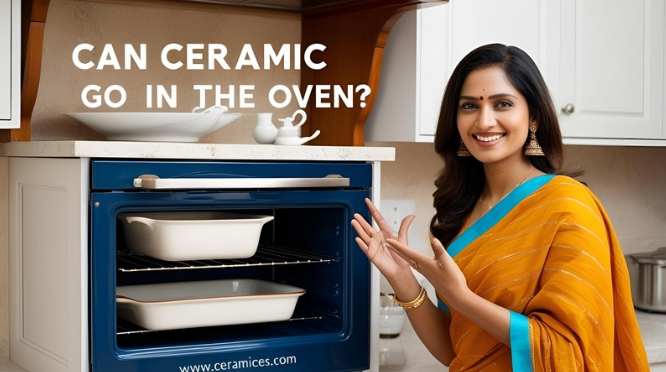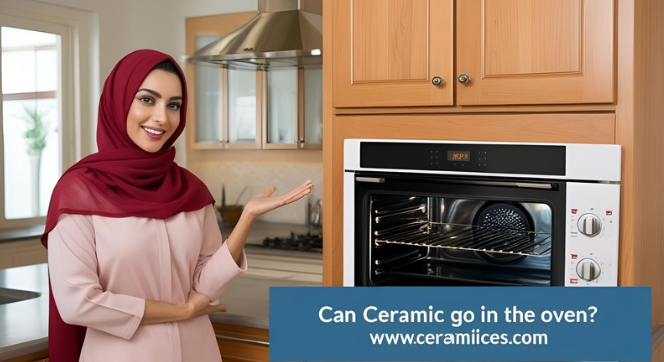Ceramic cookware and bakeware are popular choices in kitchens worldwide due to their versatility, aesthetic appeal, and excellent heat retention. However, a common question that arises is, “Can ceramic go in the oven?” This article will explore the safety and best practices for using ceramic in the oven, including the types of ceramic that are oven-safe, temperature limits, and tips for maintaining your ceramic items. Whether you’re a home cook, a baking enthusiast, or simply someone looking to make the most of your ceramic cookware, this guide will provide you with all the information you need.
What Are Ceramics?
Ceramics are inorganic, non-metallic materials made from a combination of metallic and non-metallic elements. They are typically formed by shaping and then firing at high temperatures. Ceramics are used in a wide range of applications, including cookware, bakeware, and tableware.
Key Components:
- Clay Body: The base material that gives the ceramic its shape and structure.
- Glaze: A glass-like coating applied to the ceramic to make it waterproof and add color or design.
- Design: Ceramics often feature intricate designs, patterns, or artwork.
Can Ceramic Go in the Oven?

The short answer is yes, most ceramic cookware and bakeware are oven-safe. However, there are some important considerations to keep in mind to ensure safe and effective use:
1. Oven-Safe Labels
Always check for an “oven-safe” label on your ceramic items. This label indicates that the item has been tested and approved for oven use.
2. Temperature Limits
Ceramic items have specific temperature limits, usually ranging from 350°F to 500°F (175°C to 260°C). Exceeding these limits can cause the ceramic to crack or break.
3. Thermal Shock
Ceramics can be sensitive to sudden temperature changes. Avoid placing a cold ceramic item directly into a hot oven, as this can cause thermal shock and lead to cracking.
4. Glaze Quality
High-quality, food-safe glazes are designed to withstand oven temperatures without cracking or leaching harmful chemicals. Ensure your ceramic items have a high-quality glaze.
5. Type of Ceramic
Not all ceramics are created equal. Some types, like stoneware and porcelain, are more suitable for oven use than others.
Types of Oven-Safe Ceramics
Here’s a breakdown of the different types of ceramics and their suitability for oven use:
1. Stoneware
Stoneware is a type of ceramic that is fired at high temperatures, making it durable and oven-safe. It is commonly used for baking dishes, casseroles, and pie plates.
2. Porcelain
Porcelain is a high-quality ceramic known for its strength and heat resistance. It is often used for oven-safe dishes, bakeware, and cookware.
3. Earthenware
Earthenware is a type of ceramic that is fired at lower temperatures. While it can be oven-safe, it is generally less durable than stoneware and porcelain and has lower temperature limits.
4. Ceramic-Coated Cookware
Some cookware features a ceramic coating over a metal base. These items are often oven-safe, but it’s essential to check the manufacturer’s guidelines for temperature limits.
Temperature Limits for Ceramic in the Oven

Different types of ceramics have different temperature limits. Here’s a general guide:
1. Stoneware
- Temperature Limit: Up to 500°F (260°C)
- Common Uses: Baking dishes, casseroles, pie plates
2. Porcelain
- Temperature Limit: Up to 572°F (300°C)
- Common Uses: Oven-safe dishes, bakeware, cookware
3. Earthenware
- Temperature Limit: Up to 350°F (175°C)
- Common Uses: Decorative items, some bakeware
4. Ceramic-Coated Cookware
- Temperature Limit: Varies by manufacturer; typically up to 500°F (260°C)
- Common Uses: Frying pans, saucepans, baking sheets
Tips for Using Ceramic in the Oven
To ensure the safe and effective use of ceramic in the oven, follow these tips:
1. Preheat the Oven
Always preheat the oven before placing your ceramic items inside. This helps prevent thermal shock.
2. Avoid Sudden Temperature Changes
Do not place a cold ceramic item directly into a hot oven. Allow it to come to room temperature first.
3. Use Oven Mitts
Ceramic items can become very hot in the oven. Always use oven mitts or pot holders when handling them.
4. Check for Damage
Regularly inspect your ceramic items for cracks, chips, or other damage. Damaged items should not be used in the oven.
5. Follow Manufacturer Guidelines
Adhere to the manufacturer’s guidelines for temperature limits and usage instructions.
6. Use a Trivet or Cooling Rack
Place hot ceramic items on a trivet or cooling rack after removing them from the oven to prevent damage to your countertops.
7. Avoid Broiling
Broiling involves extremely high temperatures and direct heat, which can damage ceramic items. Avoid using ceramic cookware and bakeware for broiling.
Common Uses for Oven-Safe Ceramics
Oven-safe ceramics are versatile and can be used for a variety of cooking and baking tasks:
1. Baking
Ceramic bakeware is ideal for baking casseroles, lasagnas, and desserts like cobblers and crisps.
2. Roasting
Ceramic roasting dishes are perfect for roasting meats, vegetables, and poultry.
3. Serving
Ceramic serving dishes can go directly from the oven to the table, keeping your food warm and adding a touch of elegance to your presentation.
4. Reheating
Ceramic dishes are great for reheating leftovers in the oven, ensuring even heating and preserving the flavor and texture of your food.
FAQs: Can Ceramic Go in the Oven?
1. Can ceramic go in the oven?
Yes, most ceramic cookware and bakeware are oven-safe, provided they have an “oven-safe” label and are used within their temperature limits.
2. What temperature can ceramic withstand in the oven?
Temperature limits vary by type of ceramic, but most can withstand temperatures between 350°F and 500°F (175°C to 260°C).
3. Can I put a cold ceramic dish in a hot oven?
No, placing a cold ceramic dish directly into a hot oven can cause thermal shock and lead to cracking. Allow the dish to come to room temperature first.
4. Can ceramic go in the broiler?
Broiling involves extremely high temperatures and direct heat, which can damage ceramic items. Avoid using ceramic cookware and bakeware for broiling.
5. How do I know if my ceramic dish is oven-safe?
Check for an “oven-safe” label on the dish. If there is no label, consult the manufacturer’s guidelines or perform a thermal shock test.
6. Can I use ceramic-coated cookware in the oven?
Yes, ceramic-coated cookware is often oven-safe, but it’s essential to check the manufacturer’s guidelines for temperature limits.
7. What should I do if my ceramic dish cracks in the oven?
Discard the cracked dish immediately to prevent injury or further damage. Do not attempt to use it again.
8. Can I use ceramic dishes for baking and roasting?
Yes, ceramic dishes are ideal for baking and roasting, as they provide even heat distribution and retain heat well.
9. How do I clean ceramic dishes after using them in the oven?
Wash ceramic dishes with warm, soapy water and a soft sponge. Avoid using abrasive cleaners or scouring pads.
10. Are there any eco-friendly alternatives to ceramic for oven use?
Eco-friendly alternatives include glass and cast iron, which are also oven-safe and have a lower environmental impact.
Conclusion: Can Ceramic Go in the Oven?
Yes, ceramic can go in the oven, provided it is labeled as oven-safe and used within its temperature limits. By following best practices such as preheating the oven, avoiding sudden temperature changes, and using oven mitts, you can safely and effectively use ceramic cookware and bakeware in the oven.
So, the next time you ask, “Can ceramic go in the oven?” remember that with the right precautions and high-quality ceramic items, you can enjoy the versatility and performance of ceramic in your cooking and baking. Whether you’re baking a casserole, roasting a chicken, or reheating leftovers, ceramic dishes offer a durable and stylish solution for all your oven needs. By making informed decisions and following proper care guidelines, you can extend the lifespan of your ceramic items and enjoy their benefits for years to come.
Read more
1 Are Ceramic Plates Microwave Safe?
2 Are Ceramic Mugs Microwave Safe? Using Ceramic Mugs in the Microwave